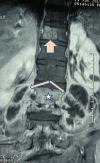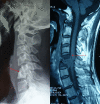Spinal tuberculosis: a review
- PMID: 22118251
- PMCID: PMC3184481
- DOI: 10.1179/2045772311Y.0000000023
Spinal tuberculosis: a review
Abstract
Spinal tuberculosis is a destructive form of tuberculosis. It accounts for approximately half of all cases of musculoskeletal tuberculosis. Spinal tuberculosis is more common in children and young adults. The incidence of spinal tuberculosis is increasing in developed nations. Genetic susceptibility to spinal tuberculosis has recently been demonstrated. Characteristically, there is destruction of the intervertebral disk space and the adjacent vertebral bodies, collapse of the spinal elements, and anterior wedging leading to kyphosis and gibbus formation. The thoracic region of vertebral column is most frequently affected. Formation of a 'cold' abscess around the lesion is another characteristic feature. The incidence of multi-level noncontiguous vertebral tuberculosis occurs more frequently than previously recognized. Common clinical manifestations include constitutional symptoms, back pain, spinal tenderness, paraplegia, and spinal deformities. For the diagnosis of spinal tuberculosis magnetic resonance imaging is more sensitive imaging technique than x-ray and more specific than computed tomography. Magnetic resonance imaging frequently demonstrates involvement of the vertebral bodies on either side of the disk, disk destruction, cold abscess, vertebral collapse, and presence of vertebral column deformities. Neuroimaging-guided needle biopsy from the affected site in the center of the vertebral body is the gold standard technique for early histopathological diagnosis. Antituberculous treatment remains the cornerstone of treatment. Surgery may be required in selected cases, e.g. large abscess formation, severe kyphosis, an evolving neurological deficit, or lack of response to medical treatment. With early diagnosis and early treatment, prognosis is generally good.
Figures





References
-
- Jain AK. Tuberculosis of the spine: a fresh look at an old disease. J Bone Joint Surg Br 2010;92(7):905–13 - PubMed
-
- Jain AK, Dhammi IK. Tuberculosis of the spine: a review. Clin Orthop Relat Res 2007;460(July):39–49 - PubMed
-
- Taylor GM, Murphy E, Hopkins R, Rutland P, Chistov Y. First report of Mycobacterium bovis DNA in human remains from the Iron Age. Microbiology 2007;153(4):1243–9 - PubMed
-
- World Health Organization. HIV/TB Facts 2011 [assessed on 2011 Jun 11]. http://www.who.int/hiv/topics/tb/hiv_tb_factsheet_june_2011.pdf .
Publication types
MeSH terms
LinkOut - more resources
Full Text Sources
